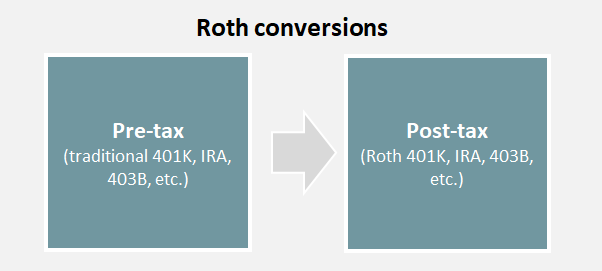
Background
Roth conversion strategies have garnered an almost mystical reputation. On the one hand, they can be one of the most impactful planning tools when it comes to retirement and tax planning. On the other hand, I find that many people (including financial professionals) talk about and implement Roth strategies, but generally do not properly optimize them.
Some of these are salespeople who talk about Roth strategies solely as a marketing strategy. They wave around the notion of a silver Roth bullet for one's tax woes, and the pitch is naturally very compelling (who likes paying taxes?). However, their Roth strategy typically amounts to little more than holding a finger to the wind.

This article is laid out in three primary sections followed by concluding remarks. The first section highlights some of the primary variables (i.e., costs and benefits) involved in determining the utility of Roth conversions. My goal is to identify the main variables and some intuition as to how they relate to Roth conversion decisions.
The second section outlines two important calculations: the amount of the Roth conversion and how much additional tax should be paid as a result of the conversion. Then, the third section discusses some of the practical logistics involved with Roth conversions.
Determining the utility of Roth conversions
In my experience, many financial professionals (and software planning tools) oversimplify decisions around Roth accounts. In particular, they tend to fixate on the tax rate that applies to a Roth conversion and compare it to what tax rates might apply down the road. This may be useful to consider and might even be the most important factor, but it ignores many other variables at play (see the list below).
The list above is not exhaustive nor does it include all of the exogenous factors related to the tax code (e.g., the expiration of the Tax Cut and Jobs Act in 2025). Moreover, these variables are interdependent. In other words, determining an optimal strategy for Roth conversions is a complex, multi-faceted challenge.
Suffice it to say, decisions around Roth conversions should not be made in a vacuum or based on rules of thumb. Instead, they should be integrated into one's broader planning strategy by accounting for and optimizing around all of the relevant variables. Unfortunately, most of the planning software packages used by financial professionals (or available directly to consumers) do not conduct a true optimization.
Simulations: Not the same as optimization

Note: Pardon the redundancy, but this is a message worth repeating.
Many people (including investment professionals) use the word optimize, but conflate this notion with simulations. Simulations involve running many different scenarios for how markets might perform based on inputs for expected returns, volatilities, and correlations. This is useful for assessing probabilities and risks regarding running out of money or estimating how much of the portfolio may be left to heirs.
In my view, providing simulations is table stakes when it comes to financial planning. Unfortunately, this does not stop many investment professionals from ignoring planning altogether or running simulations based on straight-line assumptions (i.e., assuming there is no volatility around market performance). While better than nothing, these latter types of naive analyses are not robust and can lead to difficult situations down the road (see sequence of return risk).
In addition to simulations, many of the popular financial planning software packages also offer the ability to illustrate the impact of Roth conversions based on individual scenarios (e.g., convert $100k or up to the 32% tax bracket). In other words, the prescription for Roth conversions is an input to the planning process - not an output (this is the critical distinction!). Emphatically, this is not an optimization.
Optimization: More than just simulations
There are many 1,000s of potential Roth conversion strategies that should be considered. A real optimization would iterate through these scenarios, run market simulations for each Roth strategy, and then specify which Roth strategies led to the best results.
An optimization would be aware of both one's personal situation (e.g., when one stops working) as well as future changes that are embedded in tax law (e.g., the expiration of the Tax Cut and Jobs Act or TCJA after 2025). Accordingly, an optimization might make a recommendation that includes pivot points acknowledging these details.
For example, the output from my planning process might prescribe something like this: For the years 2023-2025, implement Roth conversions until your ordinary income fills up your 32% tax bracket. Then, for years 2026-2028, make Roth conversions until your modified adjusted gross income (MAGI) reaches $194,000.
In the example above, the hypothetical prescription for the Roth conversion strategy changed after 2025 to reflect the expiration of the TCJA. It also targeted both an ordinary income tax bracket as well as a MAGI threshold.
Intuition might help explain why one would target a specific tax bracket. We may just be buying our way into lower tax brackets while the tax code is favorable. However, the MAGI threshold reflects an additional consideration. In particular, it indicates that the optimization is likely accounting for additional costs from IRMAA as it is linked directly to MAGI.
This level of analysis (e.g., accounting for IRMAA costs) may help indicate the complex nature of Roth conversion strategies (and, more generally, proper financial planning). In particular, these challenges are multi-dimensional in nature and riddled with interdependencies.
At the risk of being redundant, I want to reiterate a key point. One's Roth conversion strategy should be an output of the planning process (i.e., an optimization), not an input. Given the importance and complexity of Roth conversion decisions, we need more than market simulations to uncover the strategies that will produce the best results. This is why I believe optimizations are an absolutely critical element of the financial planning process.
Below are two links describing Roth conversions and the related calculations. As you will see, many of the factors I highlighted above are not mentioned.
- Schwab Roth conversion overview: https://www.schwab.com/learn/story/why-consider-roth-ira-conversion-and-how-to-do-it
- Schwab Roth conversion calculator: https://www.schwab.com/ira/ira-calculators/roth-ira-conversion
Calculating the amount
This section was actually going to be the focal point of this article, but the previous section turned out much longer than I anticipated (sorry!). Without further ado, let's get into the calculations.
Once you have determined that a Roth conversion makes sense for your situation and your planning or analysis has prescribed a tax bracket or level of MAGI to target (i.e., you would convert until you reach this limit), your next step is to calculate how much to convert (note: if you are someone else has prescribed a round number, then I would suspect someone is holding a finger in the wind and guestimating).
Once you have this target limit, you will effectively work backward to identify how much capacity you have left for Roth conversions. I will start with a specified tax bracket and then discuss the MAGI target.
Targeting a specific tax bracket
Let's say one wants to convert until they reach the top of the 24% bracket. That bracket is currently (in 2023) $182,100 for an individual. Moreover, let's also assume this person will use their standard deduction of $13,850. Accordingly, they would have a total capacity of $195,950 ($182,100 + $13,850) for ordinary income capacity before exceeding their targeted bracket.
Of course, we have to account for their other ordinary income (if applicable). This would include the taxable portion of their salary. That is, it would not include their pre-tax deductions (e.g., contributions to traditional retirement accounts, medical or dental insurance costs, etc.).
In addition to salary, we have to consider other sources of ordinary income. For example, they might be earning interest in money market accounts or certificates of deposit (CDs) - both of which generate ordinary income. Pension income, required minimum distributions, and Social Security (be careful with this one!) should also be considered.
Once we have a good handle on how much ordinary income will appear on the tax return, then we can simply back out how much space is left for Roth conversions. If they had a total of $100,000 in ordinary from salary and all other sources, the we simply subtract that figure from the total capacity to arrive at $95,950 ($195,950 - $100,000). In other words, we could convert up to $95,950 without exceeding the 24% tax bracket.
Targeting a MAGI threshold
As I highlighted earlier, sometimes an optimization will call for Roth conversions up to a specific level of MAGI. This typically comes up because of MAGI thresholds that determine the level of IRMAA surcharge. There are at least three key differences to be aware of with these IRMAA breakpoints:
- MAGI is very different from the calculation for taxable ordinary income above.
- The thresholds are different than the standard tax brackets. Though, some are similar and this can create confusion.
- IRMAA is like a "cliff" tax; if you go $1 over a threshold, you will trigger the next level of surcharges.
The first bullet point highlights the key difference in this calculation versus targeting a tax bracket. Our goal is to estimate our MAGI. From there, we would simply subtract it from the target MAGI level to determine our capacity for a Roth conversion.
As a refresher (or introduction for those who have not encountered it before), let's revisit what goes into MAGI by starting from the bottom and going up. First, there is adjusted gross income or AGI.
You can look at how the IRS defines AGI here, but it is basically all of your income minus certain adjustments to income (e.g., traditional IRA and HSA contributions). Notably, AGI also includes capital gains. Our calculations above for targeting ordinary income did not.
The "M" in MAGI effectively adds back other income that AGI did not include. This includes the untaxed portion of one's Social Security income, tax-exempt interest, and excluded foreign income.
Once you estimate your MAGI, then you are almost done. You simply subtract this from your targeted MAGI threshold, and that figure will be the (estimated) capacity you have left for a Roth conversion. Again, you will want to make sure you are careful due to the punitive consequences of going just $1 over an IRMAA threshold.
Given the tedious nature of these calculations, I recommend using software or a tax professional to keep your arithmetic sharp.
A quick note about targeting tax bracket vs. MAGI thresholds
The IRMAA thresholds naturally apply to those on Medicare (or who will be in two years - the lookback period!). However, the benefits of Roth conversions are commonly so great that we effectively mow right over the IRMAA thresholds. Other times, higher IRMAA surcharges are unavoidable, and we end up targeting specific tax brackets. While I occasionally try to investigate the logic, I rely on my financial planning optimization tools to determine the best strategy.

MOWING OVER IRMAA
Marginal tax estimate
The last calculation focuses on the additional taxes the Roth conversion will likely trigger. Luckily, this calculation is less tedious than those above and is effectively a with-versus-without exercise.
First, we estimate our total taxes for the year without the Roth conversion. Then we estimate them with it. That is pretty much it as all we do now is subtract the two figures. However, this assumes you have withheld taxes appropriately throughout the year. If you have over- or underpaid taxes, you may want to take that into account as well. Some of these logistics are discussed in the next section.
Implementation logistics
In addition to being careful around the tedious calculations above (especially when targeting IRMAA thresholds!), there are some practical matters worth mentioning. I list some of these below with brief descriptions.
- Liquidity: The IRS imposes various restrictions regarding accessing money within Roth accounts. Make sure you do not need the money or the applicable constraints do not prevent you from accessing these funds when you might need them.
- Pay taxes from outside (if you can): It is generally better to pay taxes from an external account rather than withholding taxes on the conversion (distribution from a traditional retirement account). This allows more money to end up inside of the Roth account. Of course, selling other assets to pay for these taxes can trigger separate capital gains taxes. However, one should account for this within the initial phase of determining the net benefits of the conversion.
- Timing: We tend to execute Roth conversions toward the end of the year. This way, we generally have more clarity on the figures going into our calculations. However, financial professionals and the custodians (where you hold your accounts) tend to get very busy later in the year. So you have to balance your timing between these two factors.
- Estimated taxes: The IRS may think that you have not paid taxes soon enough. I suggest coordinating Roth conversions with the tax professional who prepares your taxes. They may recommend submitting a 2210 form explaining why the estimated payments were not due until later in the year.
- In-plan/in-service features: Different employers have different plans (401K 403B, TSP, etc.) with varying degrees of functionality. It is worth checking to see what options are available. Moreover, you should know what constraints may apply (e.g., you may have to allocate traditional and Roth accounts the same - violating principles of asset location!)
Concluding remarks
Roth conversions can be one of the most impactful planning tools when it comes to retirement and tax planning. However, they are not as straightforward as many make them out to be. Rules of thumb or lack of broader planning can lead to suboptimal results or even backfire.
Whether it was the sheer length of this article, the technical talk about optimizations, or the many interrelated details, I hope that you come away with an appreciation of the complexity involved. Accordingly, I strongly suggest integrating (and optimizing!) these decisions within your broader financial planning.
One last sidenote: As of this writing, interest rates have risen from near-zero levels to around 5% on shorter maturities. As a result, I am encountering significant levels of interest from bank accounts, CDs, money markets, bond funds, etc.
When held in taxable accounts (e.g., in a bank, traditional brokerage, or living trust account), this interest becomes taxable as ordinary income. In particular, it takes up valuable Roth conversion capacity. Of course, proper planning should "locate" many of these instruments in traditional retirement accounts (see asset location).
Please feel free to contact me. I would greatly appreciate any and all feedback. I would also be happy to help you with your financial planning needs.
Other content
- Retirement University
- My educational videos
- My blog
- My research articles
- Illustrating the Value of Retirement Accounts
- Quantifying the Value of Retirement Accounts
- My Sensible Strategies to Reduce Your Taxes PDF guide
You may also learn more about me and my firm here:

